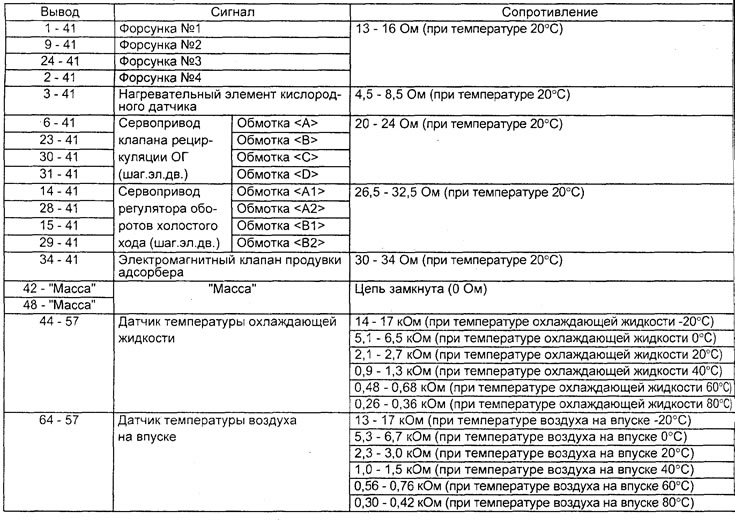Note:
- To connect an oscilloscope probe (motor tester) to the sensor under test, connect the test lead harness between the connectors (all terminals must be connected). Check on the terminals of the test harness.
- An oscilloscope sensor can be connected for testing (motor tester) to the appropriate terminal of the ECU connector, instead of connecting to the connector terminal of the sensor under test.
Mass air flow sensor (4G93 engine)
1. Connect the oscilloscope probe (motor tester) to the conclusion "3" mass air flow sensor connector.

2. Compare the waveform of the sensor on the oscilloscope with the picture when the engine is running at idle speed.

Division value: X-5 ms / d., Y - 2 V / d
3. Check that there is a period reduction "T" and an increase in the frequency of the signal with an increase in the engine speed.

4. Possible deviations from the normal waveform.
A) Due to a fault in the circuits between the mass air flow sensor and the ECM, the signal appears in the form of rectangular pulses, even if the engine is not running.
b) Due to damage to the mass air flow sensor (damage to the straightener or vortex former) the signal is present as an unstable variable frequency curve. However, if high voltage leakage occurs when the engine speed is increased (from the ignition system), then temporary distortions will appear on the curve, even if the mass air flow sensor is in good condition.

Camshaft position sensor and crankshaft position sensor
1. To check the waveform of the camshaft position sensor, connect the sensor of the motor tester to the output "2" sensor connector.

Engine 4G15.
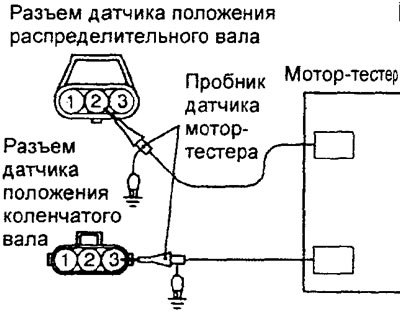
Engine 4G93.
2. To check the signal form of the crankshaft position sensor, connect the sensor of the motor tester to the output "3" sensor connector.
3. Compare the waveform of the sensor on the oscilloscope with the picture when the engine is idling. Check if period reduction occurs "T" with an increase in engine speed.

Normal waveform camshaft position sensor and crankshaft position sensor. (1) - crankshaft position sensor, (2) - camshaft position sensor. Division value: X -10 ms / d., Y - 2 V / d.
4. Possible deviations from the normal waveform.
A) Due to a fault in the circuits between the sensor and the engine control unit, the signal appears in the form of short pulses, even if the engine is not running.

b) Due to a loose timing belt or a faulty sensor rotor, the rectangular pulses will shift to the right or left.

Nozzles
1. Connect the sensor of the motor tester to the terminal "2" injector to be tested. Repeat the procedure for each injector.
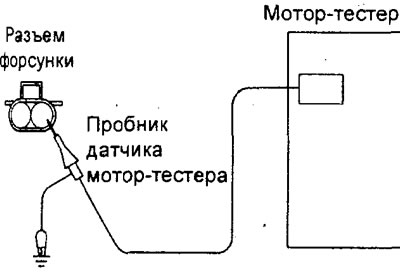
2. Check the conformity of the shape and duration of the injector control signal with the figure when the engine is running at idling speed.

The shape and duration of the injector control signal. Division value: X - 0.5 ms / d., Y -1 V / d.
3. Pay attention to the following points when observing the signal.
A) Dot "A": Amplitude (signal height) EMF of self-induction of the winding of the solenoid valve of the nozzle.
Note: due to a short circuit in the winding of the solenoid valve of the nozzle, the value of the EMF of the self-induction of the winding is small or it does not occur at all.
b) Dot "IN": Injector control signal duration (nozzle opening time).
Note: when you press the accelerator pedal sharply, the duration of the injector control signal first increases significantly, but then it will correspond to the engine speed (returns to its normal form).

Idle speed control servo
1. Connect the oscilloscope probe (motor tester) to conclusions "1", "3", "4" And "6" connector on the side of the idle speed control servo solenoid valve.

2. In the specified motor operating modes, check that during the operation of the stepper motor, a normal waveform signal appears (see picture).
A) When the ignition key is turned from the position "OFF" into position "ON", but the engine is not running (coolant temperature 20°C or lower).
b) Turn on the air conditioner while the engine is idling (turn the switch to position "ON").
V) Immediately after starting a warm engine (about 1 minute).
3. Pay attention to the following points when observing the signal.
A) Dot "A" - the presence or absence of EMF induced during the rotation of the electric motor.
Note: if the electric motor is faulty, then the back-EMF does not occur when the electric motor rotates, or its value is very small.
b) Dot "IN" - the value of the EMF of self-induction (inductive ejection, 3x10 V).
Note: if a short circuit occurs in the winding, then the self-induction EMF that occurs in the winding does not appear or its value is very small.

Division value: X-20 ms / div., Y - 1 V / div. Region "A" back-EMF that occurs when the motor rotates. Region "IN" - EMF of self-induction in the winding.
4. An example of a deviation from the normal waveform.
A) Due to a faulty stepper motor (does not work) back-EMF does not appear when the motor rotates.

b) An open in the circuit between the stepper motor and the electronic engine control unit. When the circuit is open, current does not flow in the motor winding (voltage does not drop to 0 V). Note that the back-EMF signal generated when the motor is rotating (with a good stepper motor) only slightly different from the signal when the winding circuit is broken.

EGR valve actuator (4G93 engine)
1. Disconnect valve servo connector and install test harness between connectors (all pins must be connected).
2. Connect the oscilloscope probe (motor tester) to the specified connector pins on the EGR valve servo side in the following order: "1", "3", "4" And "6".

3. At the specified motor operating modes, check that during the operation of the stepper motor, a normal waveform signal appears (see picture).
When the ignition key is turned from the position "OFF" (OFF) into position "ON" (ON), but the engine is not running.

EGR valve servo waveform. Division value: X - 25 ms / div., Y - 1 V / div. Dot "A" - counter-EMF that occurs when the motor rotates. Dot "IN" - EMF of self-induction in the winding.
4. Pay attention to the following points when observing the signal.
A) Dot "A" - the presence or absence of EMF induced during the rotation of the electric motor.
Note: if the electric motor is faulty, then the back-EMF does not occur when the electric motor rotates, or its value is very small.
b) Dot "IN" - the value of the EMF of self-induction (inductive release, 2x10 V).
Note: if a short circuit occurs in the winding, then the self-induction EMF that occurs in the winding does not appear or its value is very small.
5. An example of a deviation from the normal waveform.
A) Due to a faulty stepper motor (does not work) back-EMF does not appear when the motor rotates.

b) An open in the circuit between the stepper motor and the electronic engine control unit and automatic transmission. When the circuit is broken, no current flows in the motor winding (voltage does not drop to 0 V). Note that the back-EMF signal generated when the motor is rotating (with a good stepper motor) only slightly different from the signal when the winding circuit is broken.

Ignition coil and power transistor
1. Connect the sensor of the motor tester to the terminal "3" connector of the tested ignition coil.

2. Check that the waveform matches the figure when the engine is running at 1200 rpm.
Note: When observing the signal, pay attention to the condition of the voltage rise section and the maximum voltage.

(1) - crankshaft position sensor signal, (2) - power transistor signal. Division value: X - 10 ms/d. Y - 2 B/d.; "T" - time of rotation of the crankshaft by 180°; "T1" - time of data processing by the engine control unit; "V "- ignition timing.
3. In the normal state, a signal with a voltage rise in the upper right part (voltage rise from about "D" before "E").
Rated value:
- "D" approximately - 2.0 V
- "E" approximately - 4.5 V
4. Examples of deviations from the normal waveform (signal form: when scrolling the crankshaft of the engine with a starter).
A) Due to an open circuit in the primary» ignition coil winding rectangular signal (there is no upper right section of voltage growth), and the maximum voltage reaches only the specified» above the value "D".

b) Due to a malfunction of the power transistor when the power transistor is turned on (position "ON") supply voltage occurs (Ve-voltage of the onboard network).

Checks on the connector of the electronic engine control unit
Note:
- If any deviation from the nominal value is found, then check the corresponding sensor, actuator and corresponding wires.
- After repairing or replacing an assembly, recheck to ensure that the problem has been corrected.
Checking the voltage at the connector output from the electronic control unit
1. Disconnect the ECU connector and connect the test harness between the connectors, or use a voltmeter needle tester to test the harness-side connector.
Attention: short circuit of the positive probe connected to the connector pin on "mass", may cause damage to the wiring, sensor, electronic control unit, or all of the above items.

2. With the connector of the electronic control unit connected, measure the voltage between the terminals "mass 'of the electronic control unit and each corresponding terminal of the electronic unit connector.
3. Checked conclusions and values are indicated in the table "Checking the voltage at the terminals of the connector of the electronic engine control unit".
4. The location of the pins is shown in the corresponding figures.
Checking the resistance at the terminals of the connector of the electronic unit from the side of the wiring harness
1. Before starting the test, turn the ignition key to position "OFF" (OFF) and disconnect the ECU connector.
2. Connect the test lead harness to the connector on the harness side, then check the resistance and continuity between the connector pins.
Attention:
- Do not use ohmmeter needle probes.
- If the terminals to be tested are reversed or the terminals are incorrectly connected to "weight", the result may be damage to the wiring, sensors, electronic control unit and / or ohmmeter.
3. Checked conclusions and values are indicated in the table "Check of resistance on conclusions of a socket of the electronic control unit from a plait of wires".
4. The pinout is shown in the corresponding figure.

Connector on the side of the electronic control unit for the engine and variator (4G15 engine).
Table. Checking the voltage at the terminals of the connector of the electronic control unit for the engine and the variator (4G15 engine).
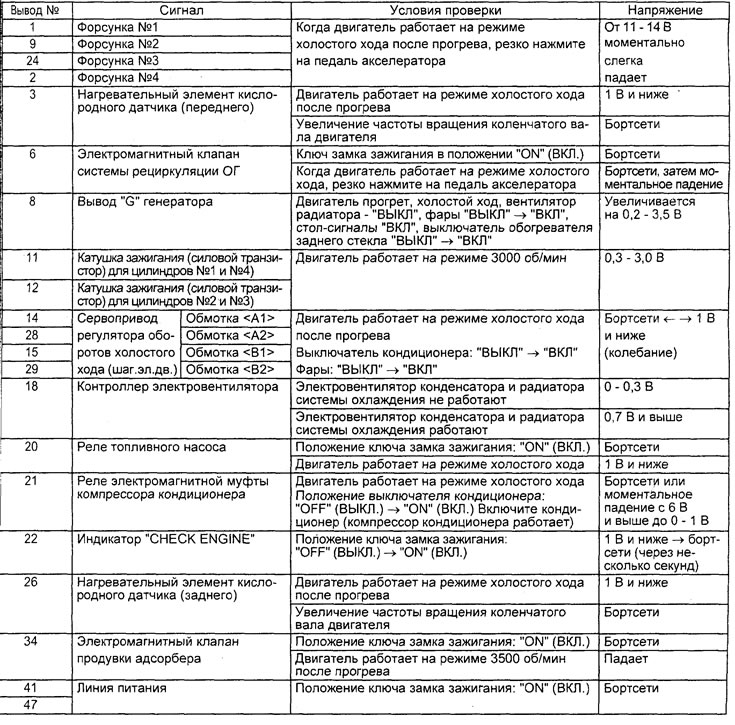

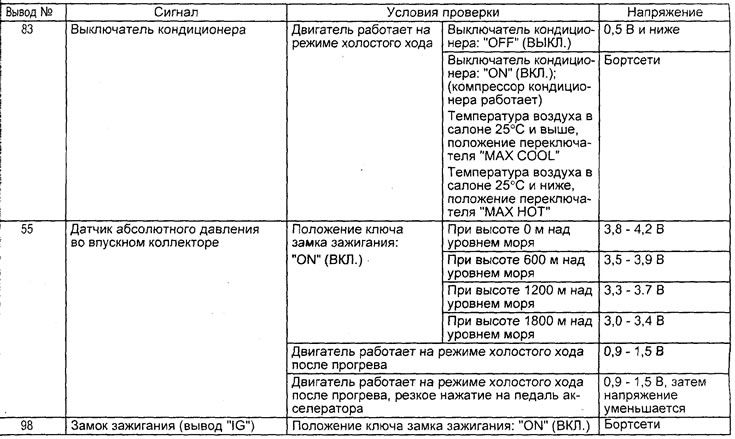

Connector on the side of the wiring harness of the electronic control unit for the engine and variator (4G15 engine)
Table. Checking the resistance between the terminals of the connector of the electronic engine control unit and the variator (engine 4G15).



Connector on the side of the electronic control unit for the engine and automatic transmission (4G93 engine).
Table. Checking the voltage at the terminals of the connector of the electronic engine control unit and AKP (4G93 engine).




Connector on the side of the wiring harness of the electronic control unit for the engine and variator (4G93 engine)
Table. Checking the resistance between the terminals of the connector of the electronic engine control unit and the variator (engine 4G93).
